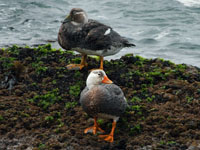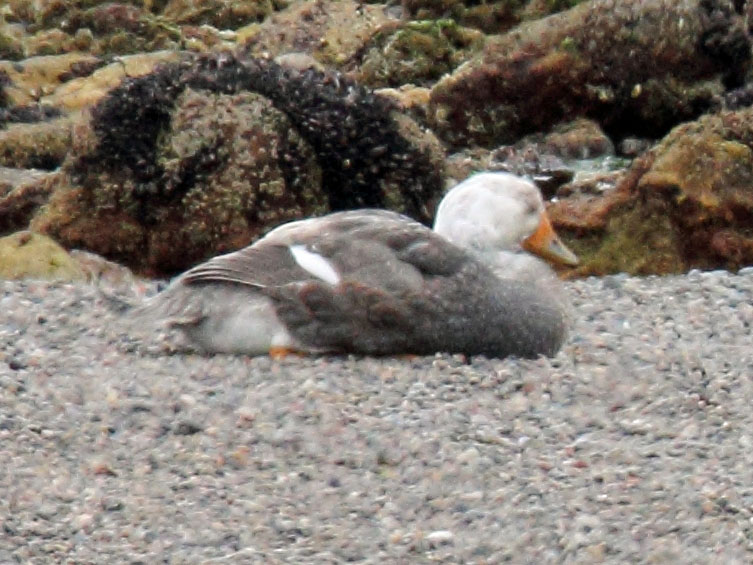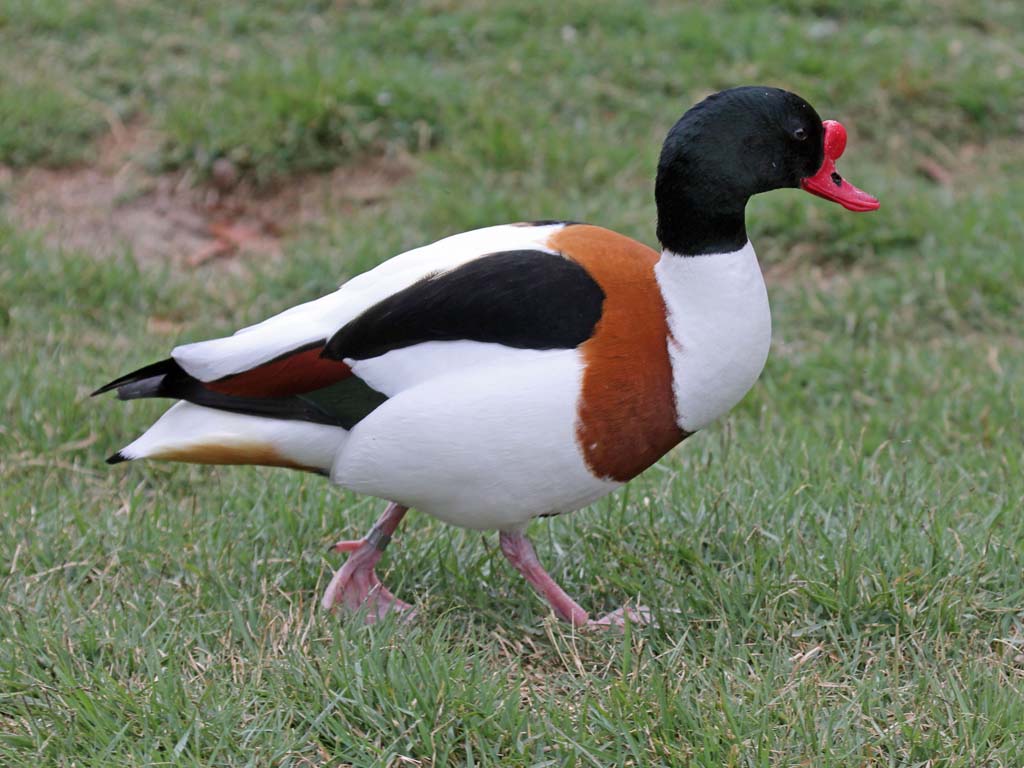The term waterfowl is used to describe any member of the order Anseriformes. A series of articles describes all the waterfowl. This specific article describes the "shelducks and sheldgeese" which belong to family Anatidae, subfamily Tadorninae.
Anseriformes
Most species of the order Anseriformes spend a considerable amount of time in water. In fact, they are called waterfowls. Their webbed feet make for efficient swimming. A few species spend little time in water and thus their feet are only partially webbed. Most waterfowl are also good flyers, many migrating long distances to escape the cold and others migrating shorter distances for optimizing their food supply. All species, except the screamers, have a wide and relatively flat bill. The shape of a species bill and also their tongue is a function of their diet. Considering the entire order, they eat aquatic plants, grasses, sedges, algae, plankton, insects, insect larvae, mollusks, crustaceans, fish, fruits, grains, rice. Most species are monogamous and if they lose a partner seem to mourn. Males are larger and heavier than females. The chicks are well developed when they hatch and can walk almost immediately.
The order Anseriformes has 3 familes: Anatidae, Anhimidae, Anseranatidae. Family Anatidae is comprised of the ducks, swans, and geese which amounts to about 160 species. Family Anhimidae is made up of 3 screamer species while family Anseranatidae has only one species, the magpie goose. Since these latter two families contain so few species, it seems appropriate to consider the entire order in this series of articles.
Anatidae
The Anatidae family has the following subfamiles:
Anatinae: dabbling ducks and teals
Anserinae: geese, swans
Aythyinae: diving ducks
Dendrocygninae: whistling ducks
Merginae: sea-ducks
Oxyurinae: stiff-tailed ducks
Plectropterinae: spur-winged goose
Stictonettinae: freckled duck
Tadorninae: shelducks, shelgeese
Sheldgeese and Shelducks
Tadorninae is the shelduck-sheldgoose subfamily of family Anatidae. This group is largely tropical or Southern Hemisphere in distribution, with only two species, the common shelduck and the ruddy shelduck breeding in northern temperate regions. The Tadorninae are somewhat intermediate between geese and dabbling ducks.
The shelgeese are South American species. These are large birds, the upland goose can be over 3 kilograms. All used to be placed in genus Chloephaga, but 4 species are now there and two others have been moved to genus Oressochen. In addition to these 6 shelgeese species, there are some other species that may have shelgeese as their closest relatives. The following are also included in this article: the Egyptian goose of Africa, the muscovy duck of South America, and the blue-winged duck of Ethiopia. The "true" shelgeese are vegetarians, as is the Egyptian goose. The muscovy duck and blue-winged duck eat plant materials, but also eat some animal protein.
There are 6 sheduck species with one in genus Radjah and the rest in Tadorna. They are omnivores, eating plants and animals such as mollusks, crustaceans, and insects. They live in Australasia, Europe, Asia, In addition to these 6 shelduck species, there are some other species that may have shelducks as their closest relatives. The following are also included in this article: mandarin and wood ducks of genus Aix, torrent duck (Merganetta armata), Salvadori's teal (Salvadorina waigiuensis), and the 4 South American steamer-ducks of genus Tachyeres. The mandarian and wood ducks are omnivores, The torrent duck, salvadori's teal and the steamer-ducks eat little plant material, instead focusing on crustaceans, mollusks, and insects.
Shelgeese
The shelgeese are South American species. These are large birds, the upland goose can be over 3 kilograms. All used to be placed in genus Chloephaga, but 4 species are now there and two others have been moved to genus Oressochen. In addition to these 6 shelgeese species, there are some other species that may have shelgeese as their closest relatives. The following are also included in this article: the Egyptian goose of Africa, the muscovy duck of South America, and the blue-winged duck of Ethiopia. The "true" shelgeese are vegetarians, as is the Egyptian goose. The muscovy duck and blue-winged duck eat plant materials, but also eat some animal protein.
Genus Chloephaga
This genus is found in southern South America. Two of the species are , for the other two species the sexes are similar in appearance.
Goose,_Ashy-headed Chloephaga poliocephala
Description: The Ashy-headed Goose has an ash-grey head and upper-neck. The lower back is brown while the mantle, lower-neck, and breast are chestnut. The beast usually has black barring. It has a white belly plus black and white barred flanks. It has a small black bill and a thin white eye-ring. The legs are orange and black, the location of these colors are variable. The wings are white except for black primary feathers.
Range: South America (southern)
Habitat: During breeding season prefers forest openings that are near waterbodies, including the sea coast. In winter favors meadows and fields. It is mainly terrestrial.
Diet: Grasses and sedges, especially their seeds. Also field stubble such as wheat and corn.
Conservation status: Least Concern.
Image by: 1) Nick Athanas - Chile 2, 3, 4) Dick Daniels - Sylvan Heights Range: South America (southern)
Habitat: During breeding season prefers forest openings that are near waterbodies, including the sea coast. In winter favors meadows and fields. It is mainly terrestrial.
Diet: Grasses and sedges, especially their seeds. Also field stubble such as wheat and corn.
Conservation status: Least Concern.
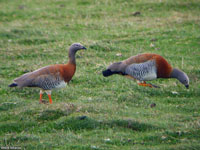
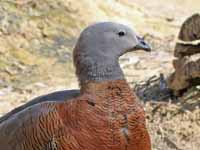
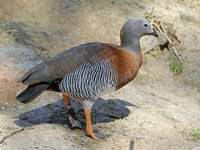
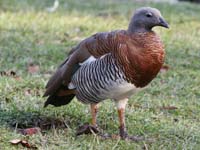
Goose,_Ruddy-headed Chloephaga rubidiceps
Description: The ruddy-headed goose has a chestnut head, upper neck, and under tail coverts. It has grey upperparts and grey underparts with fine black bars. The bill is black and the legs are yellow. The wings are white except for black primary feathers. Males and females are similar in appearance, but the males are larger. The female upland goose is similar to either sex of the ruddy-headed goose. The ruddy-headed goose has white eye-rings while the upland goose does not.
Range: South America. Most reside on the Falkland Islands where they do not migrate.
Habitat: Open grasslands. It rarely swims.
Diet: Seeds of grasses and sedges. Also other parts of plants.
Conservation status: Least Concern.
Image by: 1, 2) Dick Daniels - Sylvan Heights 3) FactumquintusRange: South America. Most reside on the Falkland Islands where they do not migrate.
Habitat: Open grasslands. It rarely swims.
Diet: Seeds of grasses and sedges. Also other parts of plants.
Conservation status: Least Concern.
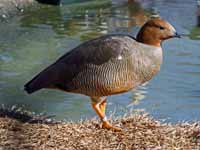
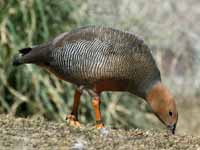

Goose,_Kelp Chloephaga hybrida
Description: The Kelp Goose feeds on seaweed. It has yellow legs. The male is white with a dark bill and eyes. The female has dark brown plumage overall with grey barring on the underparts and a white eye-ring.
Range: South America (southern)
Habitat: Breeds on coastal lakes; winters on rocky shores.
Diet: Seaweed, algae, grass. Mainly grazes for food, occasionally dabbles.
Conservation status: Least Concern.
Image by: 1) Teleuko 2) dFaulder - Argentina 3) Eduardo_Schmeda 4) Athanas Range: South America (southern)
Habitat: Breeds on coastal lakes; winters on rocky shores.
Diet: Seaweed, algae, grass. Mainly grazes for food, occasionally dabbles.
Conservation status: Least Concern.
1, 2) Female 3, 4) Male
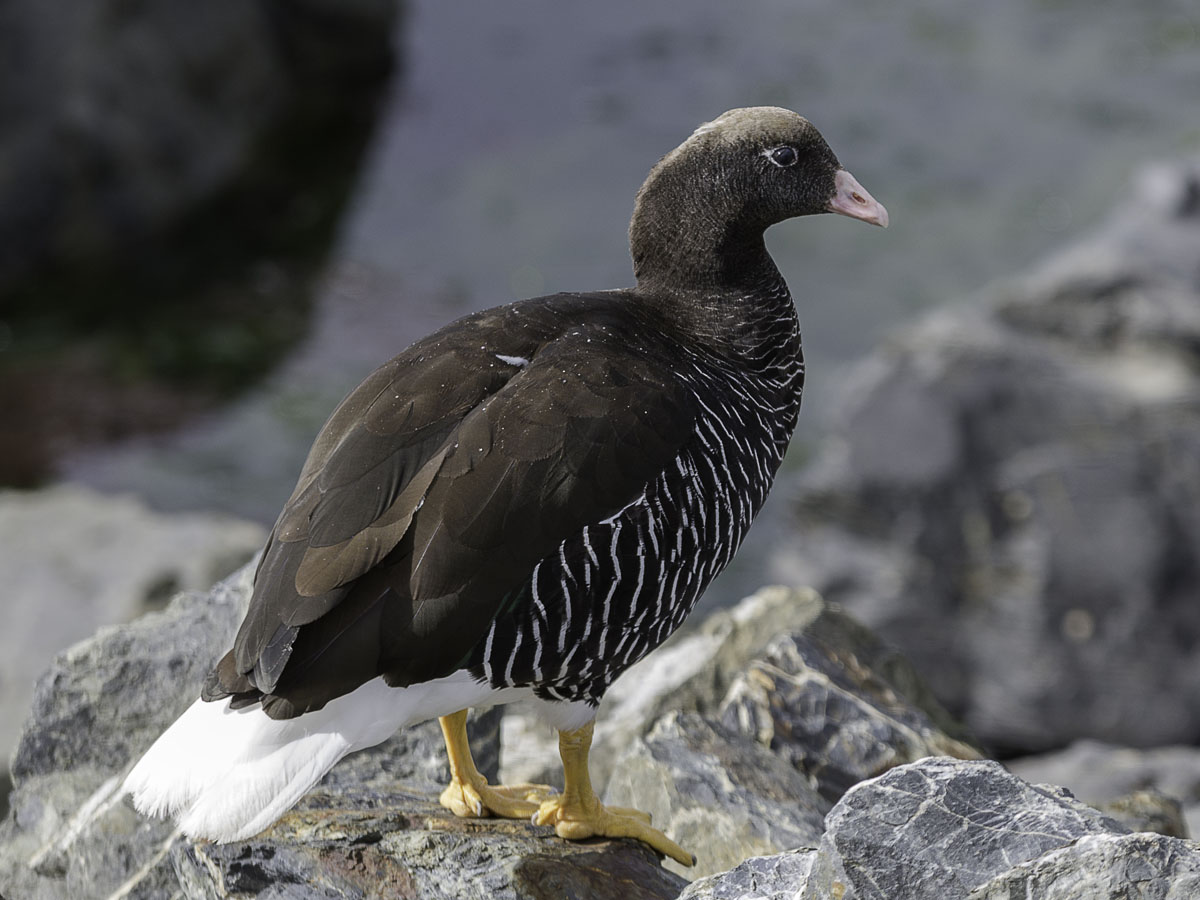
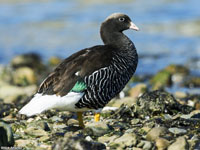
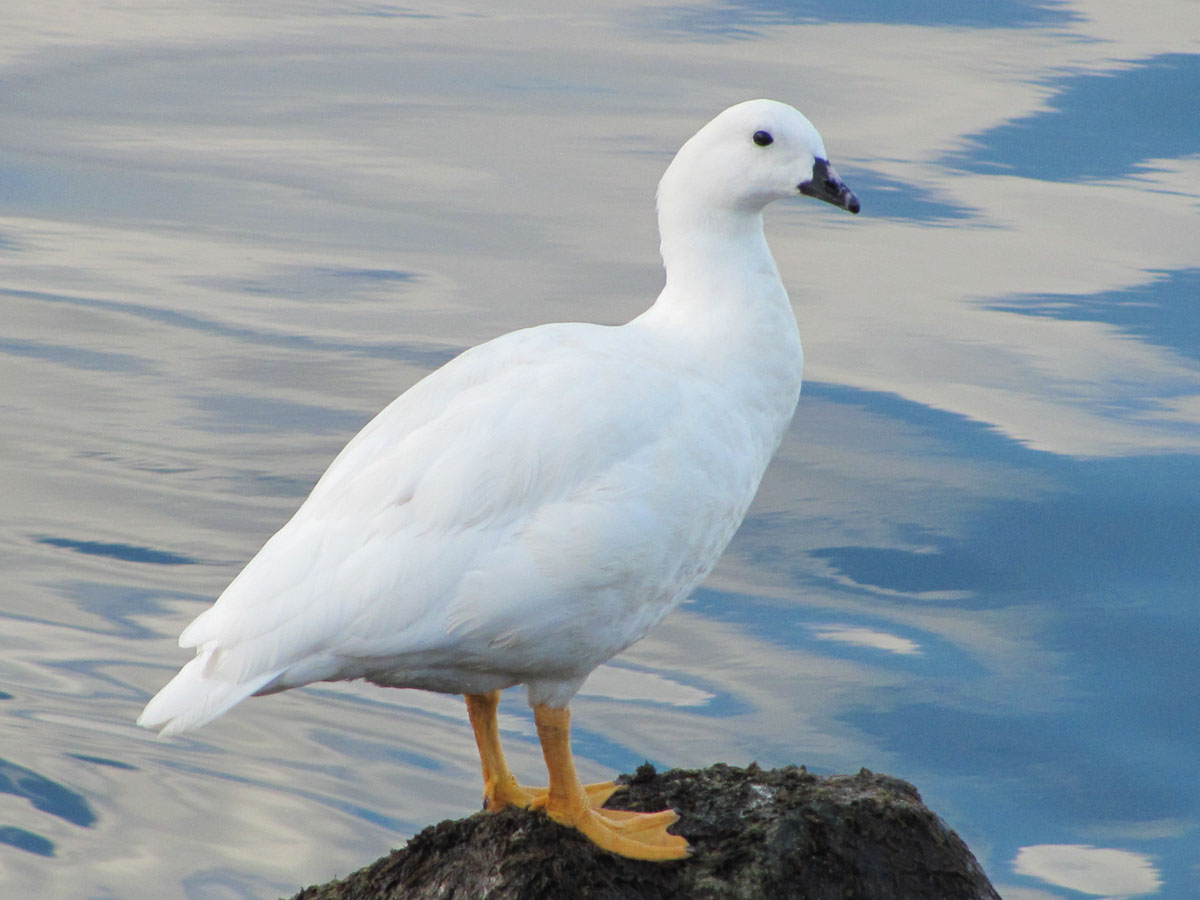
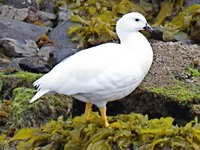
Goose,_Upland Chloephaga picta
Description: The male upland goose, also known as the Magellan goose, has a white head and neck. The bill, eyes, and legs are black. There are two morphs: one has the entire underparts barred black and white; the other has the flanks barred black and white with the rest of the underparts white. The female is brown with barring on the underparts. She has yellow legs. The female upland goose is similar to either sex of the ruddy-headed goose. The ruddy-headed goose has white eye-rings while the upland goose does not.
Range: South America (southern)
Habitat: Open grasslands.
Diet: Seeds of grasses and sedges. Also other parts of plants.
Conservation status: Least Concern.
Image by: 1) Rodrigo Schulz - Chile 2) Bernard_Dupont 3) Dick Daniels - Sylvan Heights 4) Tom_Cadwallender - ChileRange: South America (southern)
Habitat: Open grasslands.
Diet: Seeds of grasses and sedges. Also other parts of plants.
Conservation status: Least Concern.
1, 2) Female 3) Male 4) Barred morph male
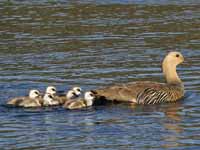
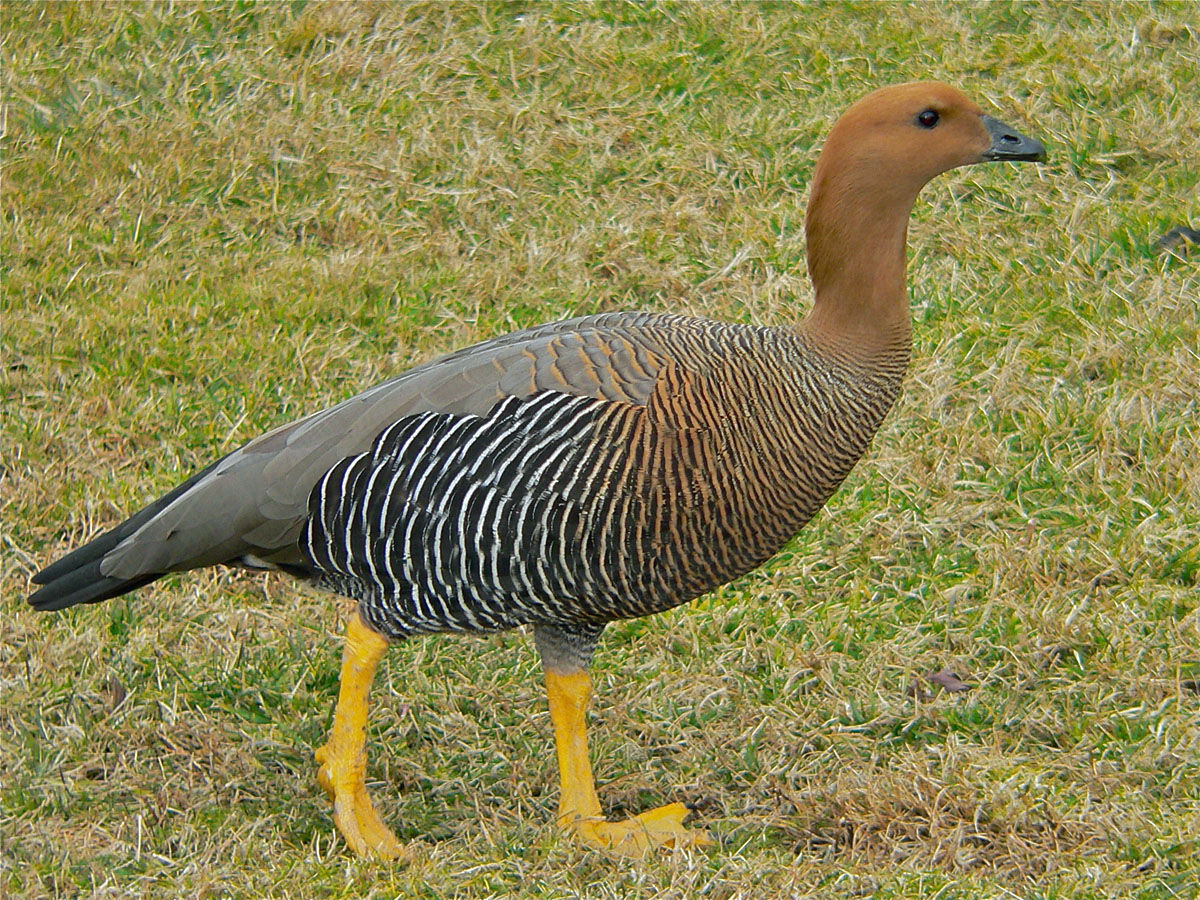
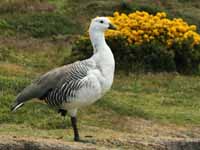
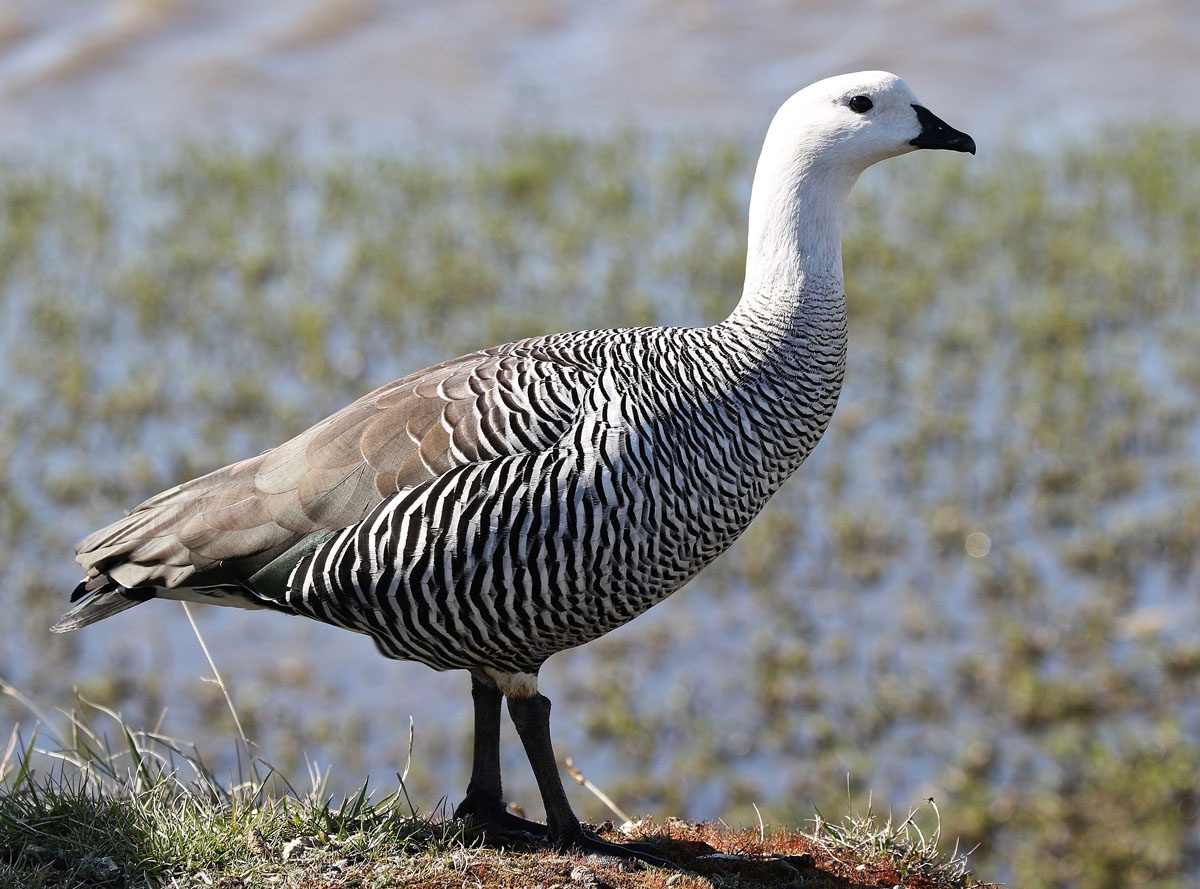
Genus Oressochen
Both species in this genus are placed by some in other genera. The Andean goose, which is treated here as Oressochen melanopterus, is alternatively considered to be Chloephaga melanoptera. And the Orinoco goose, considered here as Oressochen jubatus, is alternatively considered to be Neochen jubata.
Goose,_Andean Oressochen melanopterus
Description: The Andean Goose has a white head, neck, and underparts. The small bill is pink. The upperparts are white at the shoulders and become blacker progressing towards the tail.
Range: South America.
Habitat: Near lakes and marshes in the Andes. Not usually found in water except with young.
Diet: Grasses which it obtains by grazing.
Conservation status: Least Concern.
Image by: 1) Dick Daniels - Sylvan Heights 2) BS_Thurner_Hof 3) Paul_Balfe 4) Greg SchechterRange: South America.
Habitat: Near lakes and marshes in the Andes. Not usually found in water except with young.
Diet: Grasses which it obtains by grazing.
Conservation status: Least Concern.
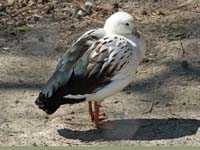

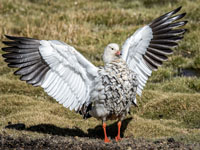
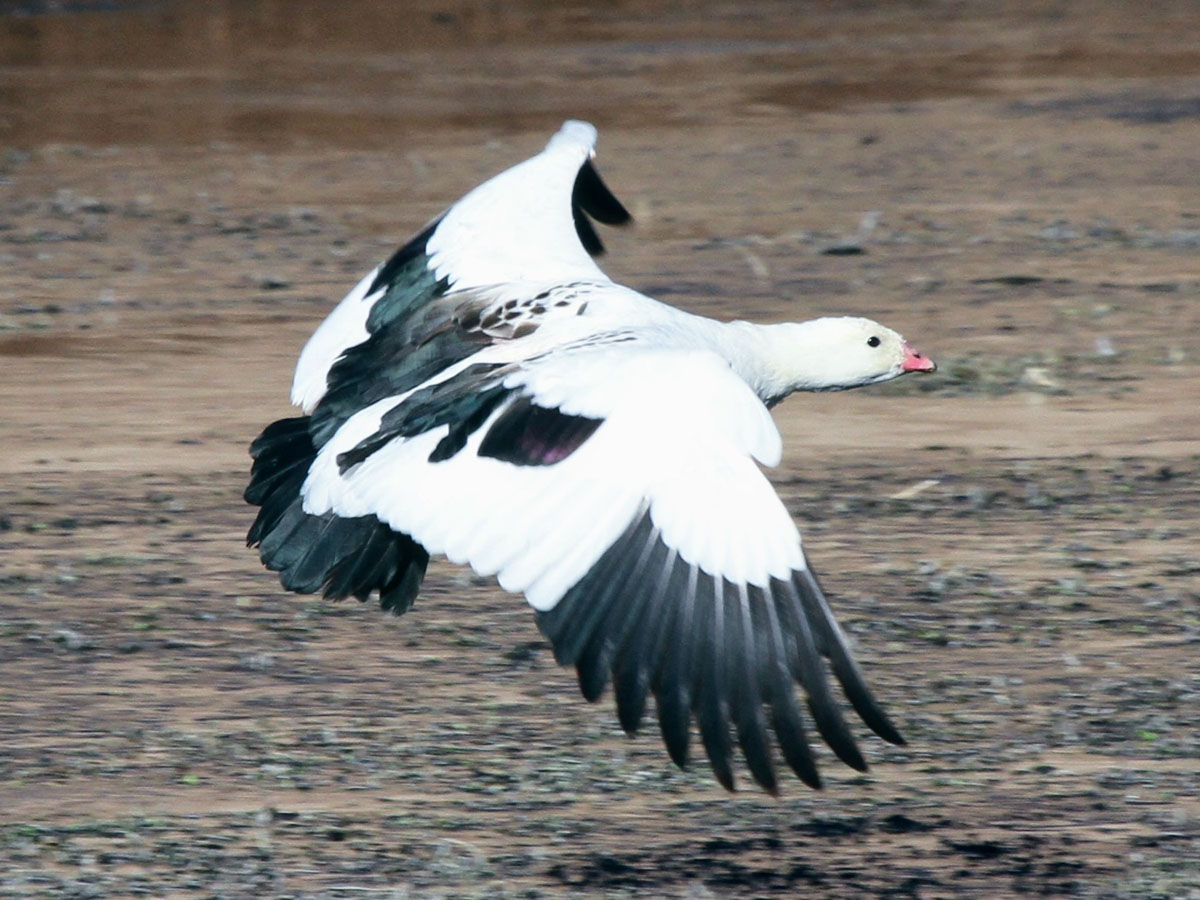
Goose,_Orinoco Oressochen jubatus
Description: The Orinoco goose has a pale head, neck, and breast. It has chestnut flanks and belly, mainly black bill, and reddish-orange legs. The lower belly and tail are black.
It is mainly a terrestrial bird - infrequently swims or files. It is similar to the blue-winged goose, but their ranges do not overlap.
Range: South America.
Habitat: Wet treed grasslands. Beaches and river banks in the dry season.
Diet: Grasses and sedges seeds, leaves, roots.
Conservation status: The Orinico goose is considered Near Threatened. The population is still over 10,000, but hunting and loss of cavity trees for nesting are stresses.
Image by: 1) Dick Daniels - Sylvan Heights 2) Tom_Friedel (BirdPhotos.com) 3) Dick - Jacksonville Zoo 4) Sandy Cole - Sylvan HeightsRange: South America.
Habitat: Wet treed grasslands. Beaches and river banks in the dry season.
Diet: Grasses and sedges seeds, leaves, roots.
Conservation status: The Orinico goose is considered Near Threatened. The population is still over 10,000, but hunting and loss of cavity trees for nesting are stresses.
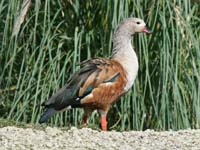
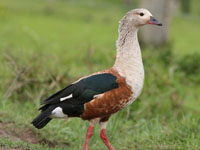
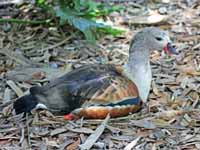
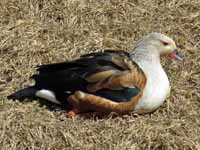
Genus Alopochen - 1 species
The Egyptian goose is placed in the shelduck subfamily. Because of its size, some over 2000 grams, it is placed here with the shelgeese.
Goose,_Egyptian Alopochen aegyptiaca
Description: The Egyptian goose has a brown back, grey underparts, and a dark brown eye patch. The bill, legs, and feet are pink. It has the general shape of a goose, but does not belong to the goose/swan subfamily. The sexes have mostly the same appearance, but the male is larger and has a thicker neck.
Range: Africa. Also in North America, Europe.
Habitat: Mainly terrestrial, but may be found swimming.
Diet: Vegetarian. They especially like crop fields such as corn, wheat, oats and thus are often considered as a pest.
Conservation status: Least Concern.
Image by: 1) Dick Daniels - Tanzania 2) Dick - Kenya 3, 4) Dick - Johaneesburg Range: Africa. Also in North America, Europe.
Habitat: Mainly terrestrial, but may be found swimming.
Diet: Vegetarian. They especially like crop fields such as corn, wheat, oats and thus are often considered as a pest.
Conservation status: Least Concern.
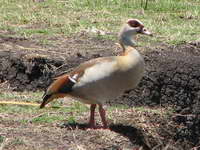

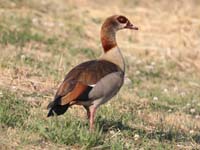
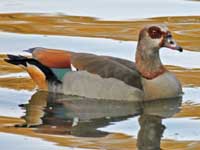
Genus Cairina
This genus now only contains the muscovy ducks. It formerly included the white-winged wood duck, but DNA evidence implies it is only distantly related to muscovy ducks. Muscovy ducks seem to be more related to those in the Aix genus which are considered to be part of the shelduck. Since muscovys are large and have a goose-like appearance, they have been placed here near the shelgeese.
Duck, Muscovy Cairina moschata
Description: The muscovy duck is black with a metalic sheen. It has a white wing patch.The population of feral muscovy duck is so large that it is difficult to determine if one in the wild is genetically pure. If there is much white on the bird then it is almost certainly feral.
Range: Central and South America. Feral in North America
Habitat: Lowland waterbodies near or surrounded by trees. Feral population is acclimated to people.
Diet: Aquatic vegetation, grains, nuts, insects, crustaceans, fish.
Conservation status: Least Concern.
Image by: 1) Sandy Cole - Sylvan Heights 2) Cristiano Crolle - Argentina 3) Dick - California 4) Jason Pratt Video by Avibirds. Range: Central and South America. Feral in North America
Habitat: Lowland waterbodies near or surrounded by trees. Feral population is acclimated to people.
Diet: Aquatic vegetation, grains, nuts, insects, crustaceans, fish.
Conservation status: Least Concern.
1 - 5) Natural Muscovy Ducks 6 - 9) Feral Muscovy Ducks
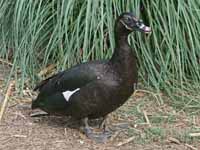
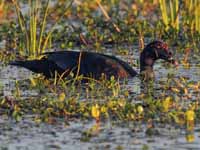
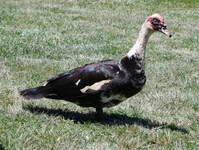
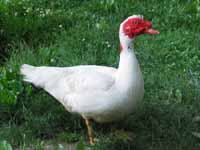
Genus Cyanochen - 1 species
It is unresolved whether or not the blue-winged goose is a shelgoose. It might belong to a very distinct and ancient "duck" clade, together with Hartlaub's duck which for now is placed with the "dabbling ducks".
Goose,_Blue-winged Cyanochen cyanoptera
Description: The blue-winged goose is stocky and grey-brown. The head and neck are lighter than the rest of the plumage. The blue wings may usually be seen while the bird is at rest. It is a quiet species, the call being a soft whistle - very different from the honking of true geese. It is similar to the Orinoco goose, but their ranges do not overlap.
Range: Ethiopia.
Habitat: Mainly rivers, but also freshwater lakes, ponds, and marshes. Grasslands and shrublands that are near freshwater, especially rivers. Seldom swims.
Diet: Grasses, sedges, insect larvae, snails.
Conservation status: The blue-winged goose is Vulnerable because of wetland destruction of breeding grounds.
Image: 1, 2, 3) Dick Daniels - Sylvan Heights Range: Ethiopia.
Habitat: Mainly rivers, but also freshwater lakes, ponds, and marshes. Grasslands and shrublands that are near freshwater, especially rivers. Seldom swims.
Diet: Grasses, sedges, insect larvae, snails.
Conservation status: The blue-winged goose is Vulnerable because of wetland destruction of breeding grounds.
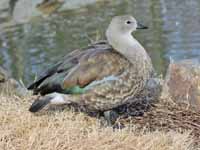
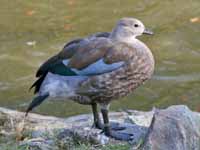

Shelducks
There are 6 sheduck species with one in genus Radjah and the rest in Tadorna. They are omnivores, eating plants and invertebrates such as mollusks, crustaceans, and insects. They live in Austalasia, Europe, Asia. In addition to these 6 shelduck species, there are some other species that may have shelducks as their closest relatives. The following are also included in this article: mandarin and wood ducks of genus Aix, torrent duck (Merganetta armata), Salvadori's teal (Salvadorina waigiuensis), and the 4 South American steamer-ducks of genus Tachyeres. The mandarin and wood ducks are omnivores, The torrent duck, Salvadori's teal and the steamer-ducks eat little plant material, instead focusing on crustaceans, mollusks, and insects.
Genus Radjah
The Radjah shelduck was formerly placed in Tadorna, but its appearance is quite different from those species so it has been given its own genus.
Shelduck, Radjah Radjah radjah
Description: The Radjah shelduck, also known as the raja shelduck, has mostly black upperparts, a white head, white underparts, and a dark breast band. It has a pale pink bill and white eyes. The wings have black primaries, black secondaries with white trailing edges, and white coverts.
Range: Australia.
Habitat: Coastal brackish waterbodies, freshwater.
Diet: Mollusks, aquatic insects, worms. Also sedges, algae.
Conservation status: Least Concern.
Image by: 1, 2) Dick Daniels - Sylvan Heights 3, 4) JJ_Harrison Range: Australia.
Habitat: Coastal brackish waterbodies, freshwater.
Diet: Mollusks, aquatic insects, worms. Also sedges, algae.
Conservation status: Least Concern.
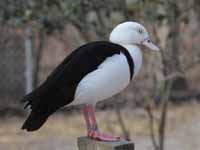

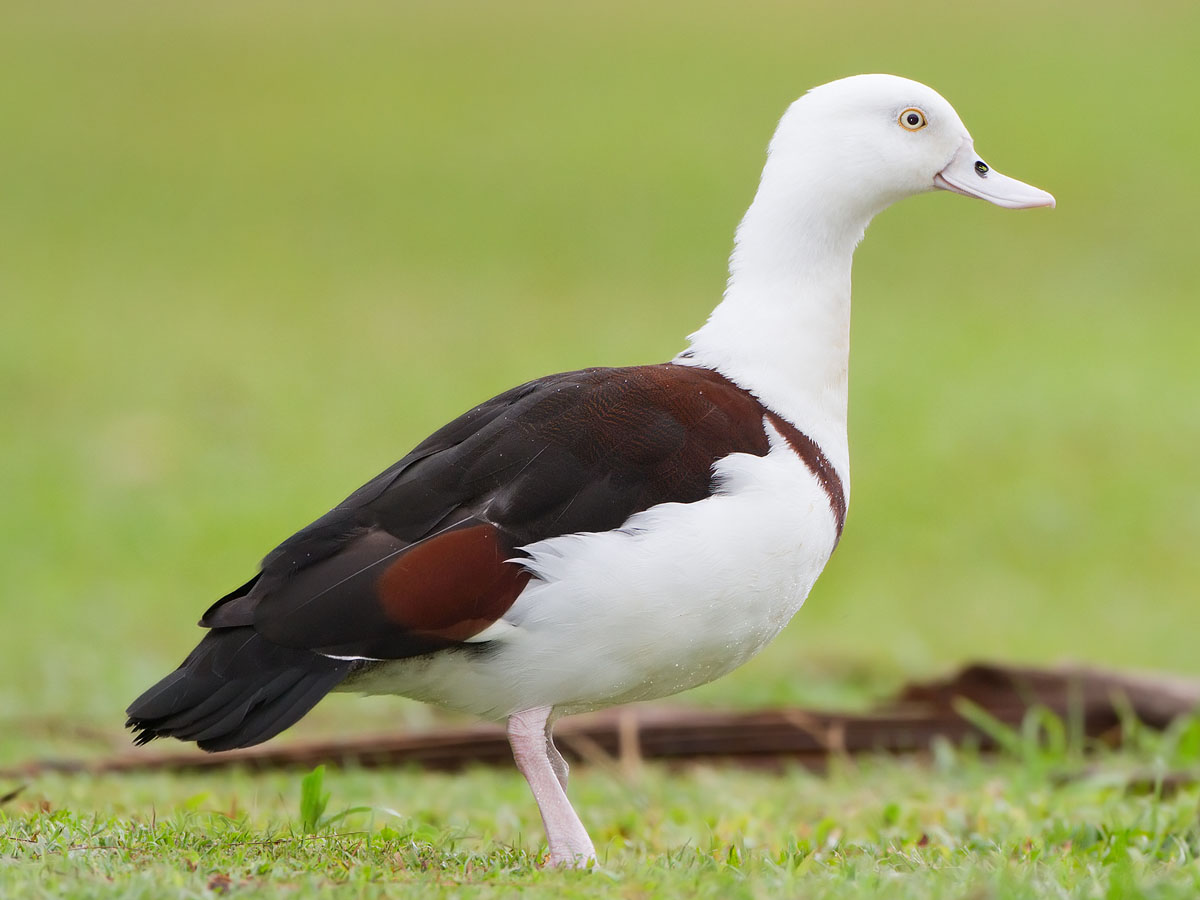
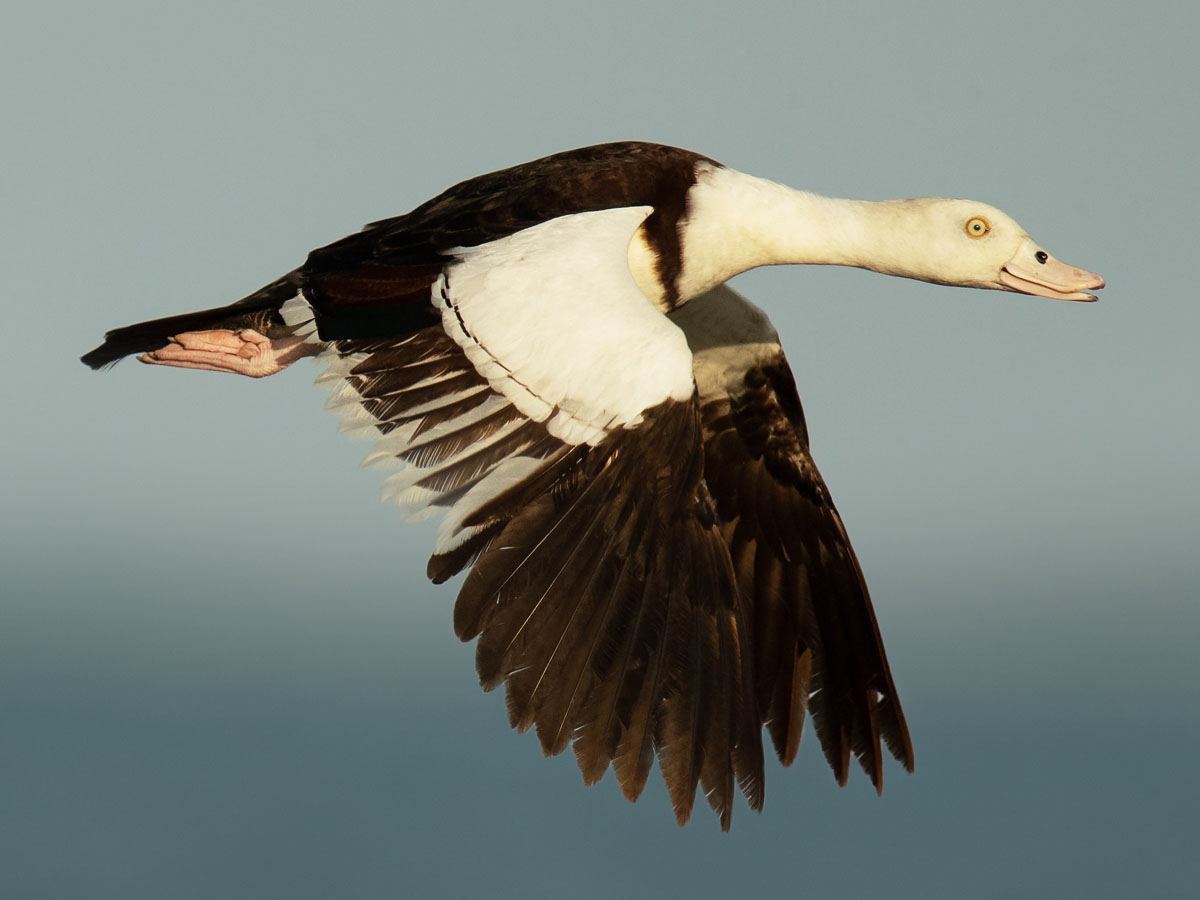
Genus Tadorana
The shelducks are mid-sized ( 50–60 cm in length) Old World waterfowl. The sexes are colored slightly differently in most species, and all have a characteristic upper-wing coloration in flight: a green speculum, plus black secondaries and primaries. The wing coverts (forewing) are white. Their diet consists of small shore animals (crustaceans such as crags, etc.) as well as grasses and other plants.
Shelduck, Australian Tadorna tadornoides
Description: The Australian shelduck has a dark green head, chestnut breast, white collar, and a dark back. The female has white around the eyes and the base of the bill.
Range: Australia.
Habitat: Lakes and other large waterbodies, preferably with trees close by.
Diet: Grasses, sedges, aquatic plants, aquatic insects, crustaceans, mollusks, fish. Forages by skimming water surface, dabbling, grazing.
Conservation status: Least Concern.
Image by: 1, 3) JJ_Harrison 2, 4) Dick - Sylvan Heights Range: Australia.
Habitat: Lakes and other large waterbodies, preferably with trees close by.
Diet: Grasses, sedges, aquatic plants, aquatic insects, crustaceans, mollusks, fish. Forages by skimming water surface, dabbling, grazing.
Conservation status: Least Concern.
1 - 4) Female 4 - 8) Male
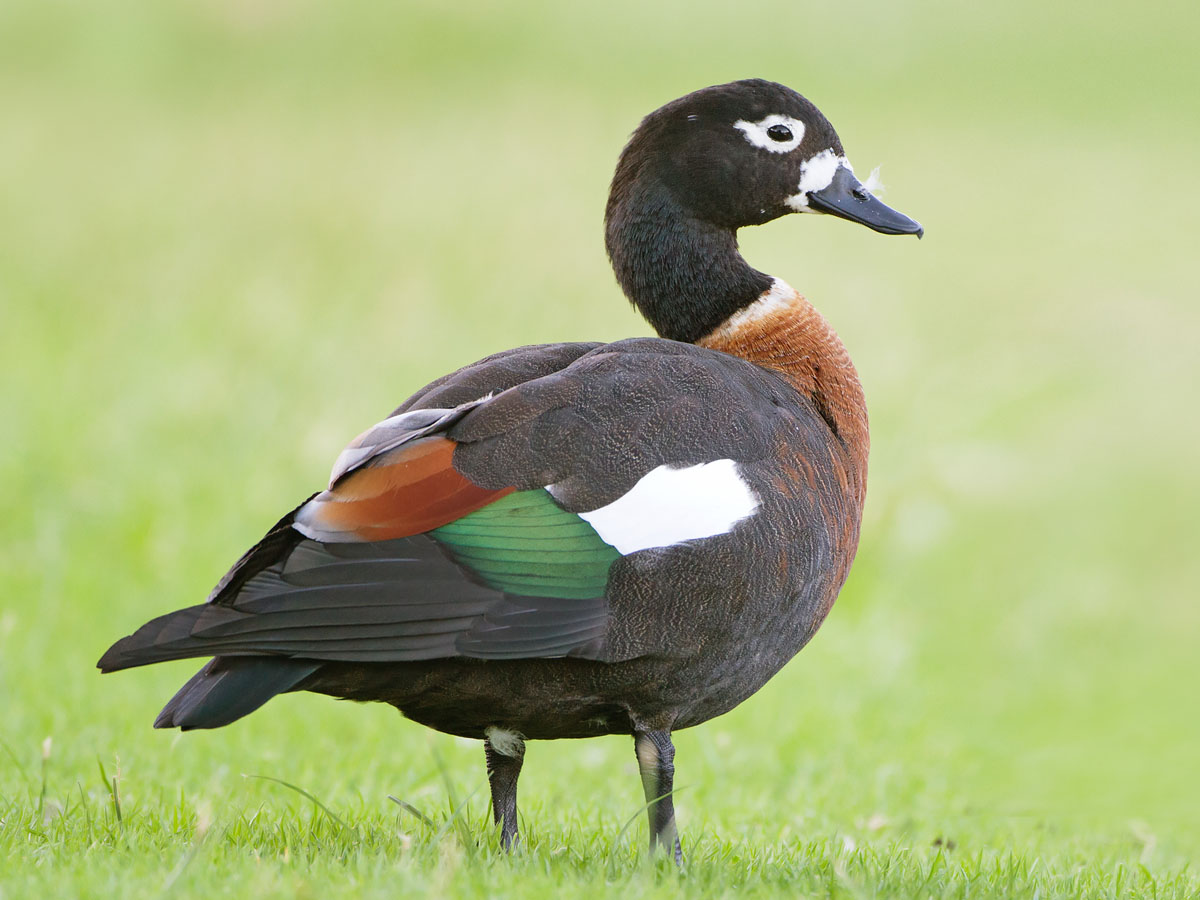
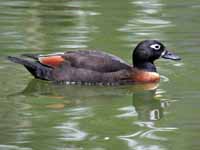
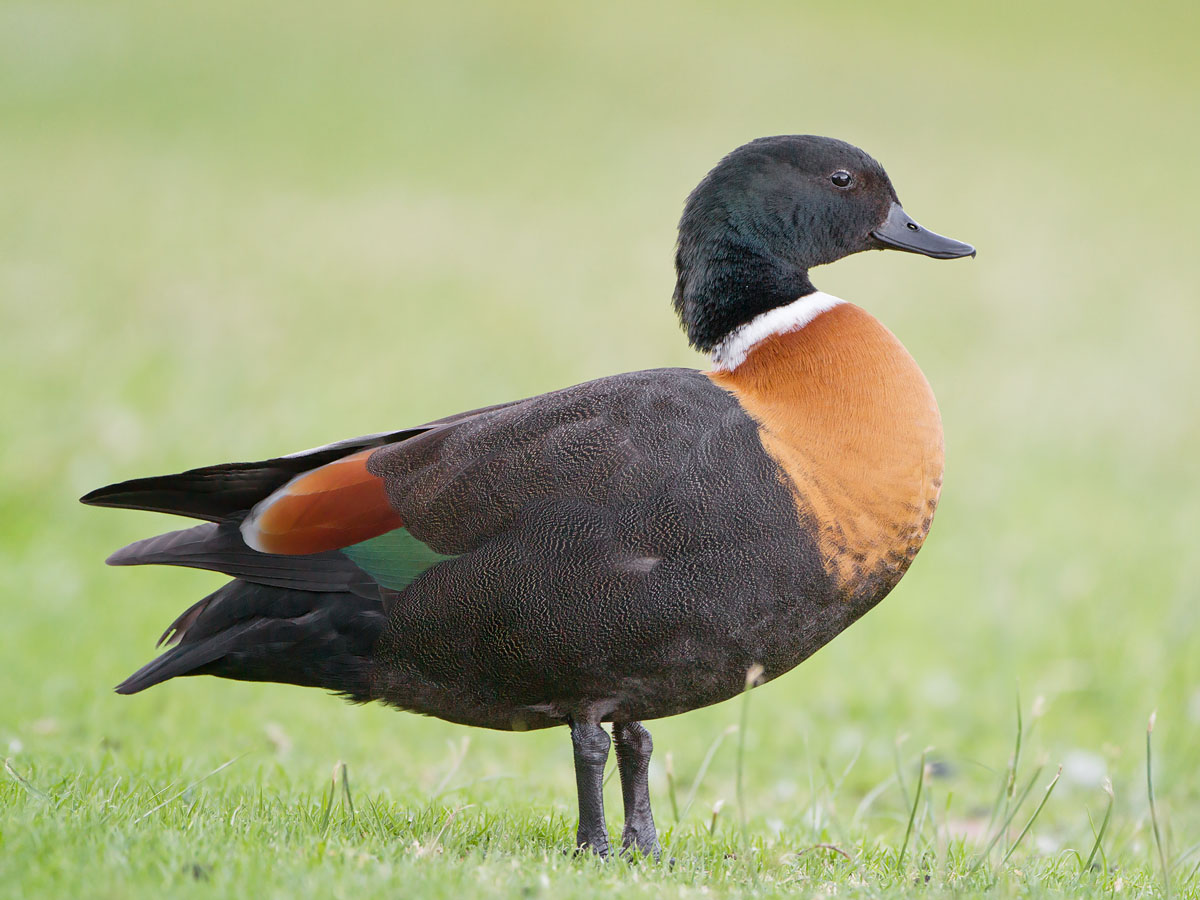
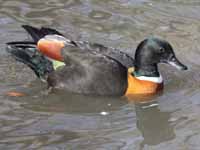
Shelduck, Common Tadorna tadorna
Description: The common shelduck has a white body with achestnut band across the shoulders which becomes a black breast-band. The head and neck are dark green. It has a reddish-pink bill and pink feet. The male has a large knob on its forehead, the female does not.
Range: Europe, Asia.
Habitat: Salt, brackish or fresh waterbodies. Northern populations migrate south for the winter.
Diet: Mollusks, aquatic insects, crustaceans, fish, aquatic vegetation. Forages by dabbling or skimming water surface,
Conservation status: Least Concern.
Image by: 1, 3, 4)
Dick Daniels - Sylvan Heights 2) Dick - Birds
of Eden, South Africa
Video by Avibirds.Range: Europe, Asia.
Habitat: Salt, brackish or fresh waterbodies. Northern populations migrate south for the winter.
Diet: Mollusks, aquatic insects, crustaceans, fish, aquatic vegetation. Forages by dabbling or skimming water surface,
Conservation status: Least Concern.
1, 2) Female 3, 4) Male
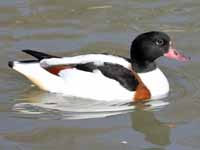

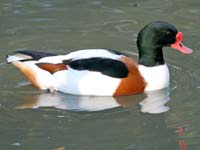
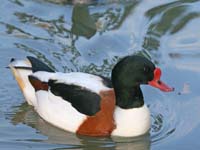
Shelduck, Paradise Tadorna variegata
Description: The male paradise shelduck has a black head and neck. The upperparts are mainly black with vermiculations. The underparts are also black and it has a chestnut rump. The female has a white head and chestnut body. Their bills and legs are black. The female paradise shelduck resembles the ruddy shelduck, but their ranges do not overlap.
Range: New Zealand.
Habitat: Pastures and grasslands, but near water for safety. The young feed via waterbodies for the first month.
Diet: Seeds of grasses and sedges, clover. Also crustaceans, insects.
Conservation status: Least Concern.
Image by: 1, 4) Dick Daniels - Sylvan Heights 2, 3) Dick - New Zealand Range: New Zealand.
Habitat: Pastures and grasslands, but near water for safety. The young feed via waterbodies for the first month.
Diet: Seeds of grasses and sedges, clover. Also crustaceans, insects.
Conservation status: Least Concern.
1) Pair 2) Female 3, 4) Male
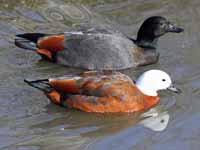
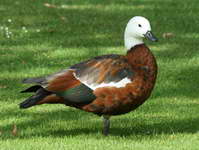
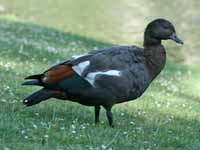

Shelduck, Ruddy Tadorna ferruginea
Description: The ruddy shelduck has an orange-brown body and a paler head. The wings have black primary feathers, green speculum, and white wing coverts. The under-wings are mainly white with black primary feathers. In the breeding season the male has a ring aroung the neck, the female does not. It is similar to the female paradise shelduck, but their ranges do not overlap.
Range: Mainly Europe, Asia. Also Africa
Habitat: Inland waterbodies such as lakes, reservoirs and rivers.
Diet: Grasses, aquatic plants, aquatic insects, mollusks, crustaceans. Grazes, dabbles, but does not dive.
Conservation status: Least Concern.
Image by: 1) Jill Mitchell 2) Dick Daniels - Miami Zoo 3) Arpingstone - England 4) Imran_Shah Video by Avibirds. Range: Mainly Europe, Asia. Also Africa
Habitat: Inland waterbodies such as lakes, reservoirs and rivers.
Diet: Grasses, aquatic plants, aquatic insects, mollusks, crustaceans. Grazes, dabbles, but does not dive.
Conservation status: Least Concern.
1) Male
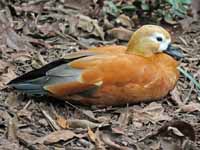
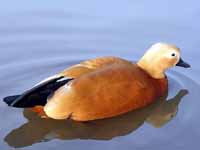
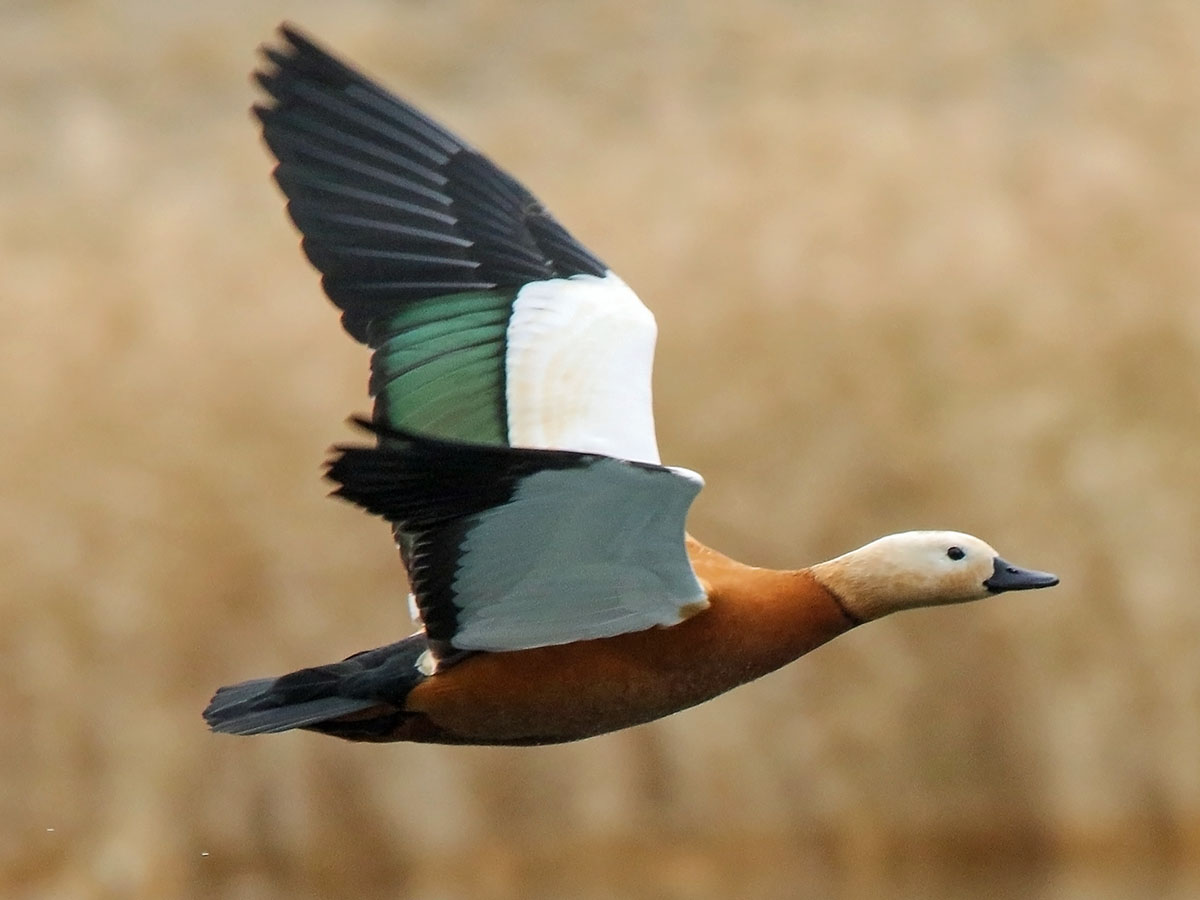
Shhelduck, South African Tadorna cana
Description: The South African shelduck, also known as the Cape shelduck, has a chestnut body marked with black, white and green. The male has a grey head; the female has white face, black crown, and nape. The female South African shelduck is similar to the white-faced whistling-duck.That has a vertical black-white boundary on its head while the female Cape Shelduck black-white areas are more random.
Range: Africa (southern).
Habitat: Fresh and brackish waterbodies, treed grasslands. Nests in tree hollows and other hollows.
Diet: During breeding season: vegetation and larvae, crustaceans. Otherwise mainly vegetarian: grains and algae.
Conservation status: Least Concern.
Image by: 1) Dick - Tampa's
Lowry Park Zoo 2) Dick - National Aviary 3) Sergey
Yeliseev -
Moscow Zoo 4) JeanRange: Africa (southern).
Habitat: Fresh and brackish waterbodies, treed grasslands. Nests in tree hollows and other hollows.
Diet: During breeding season: vegetation and larvae, crustaceans. Otherwise mainly vegetarian: grains and algae.
Conservation status: Least Concern.
1, 2) Female 3, 4) Male
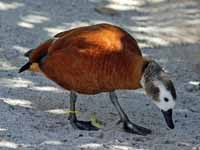
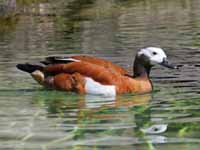
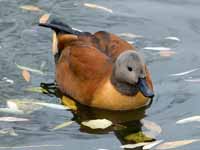
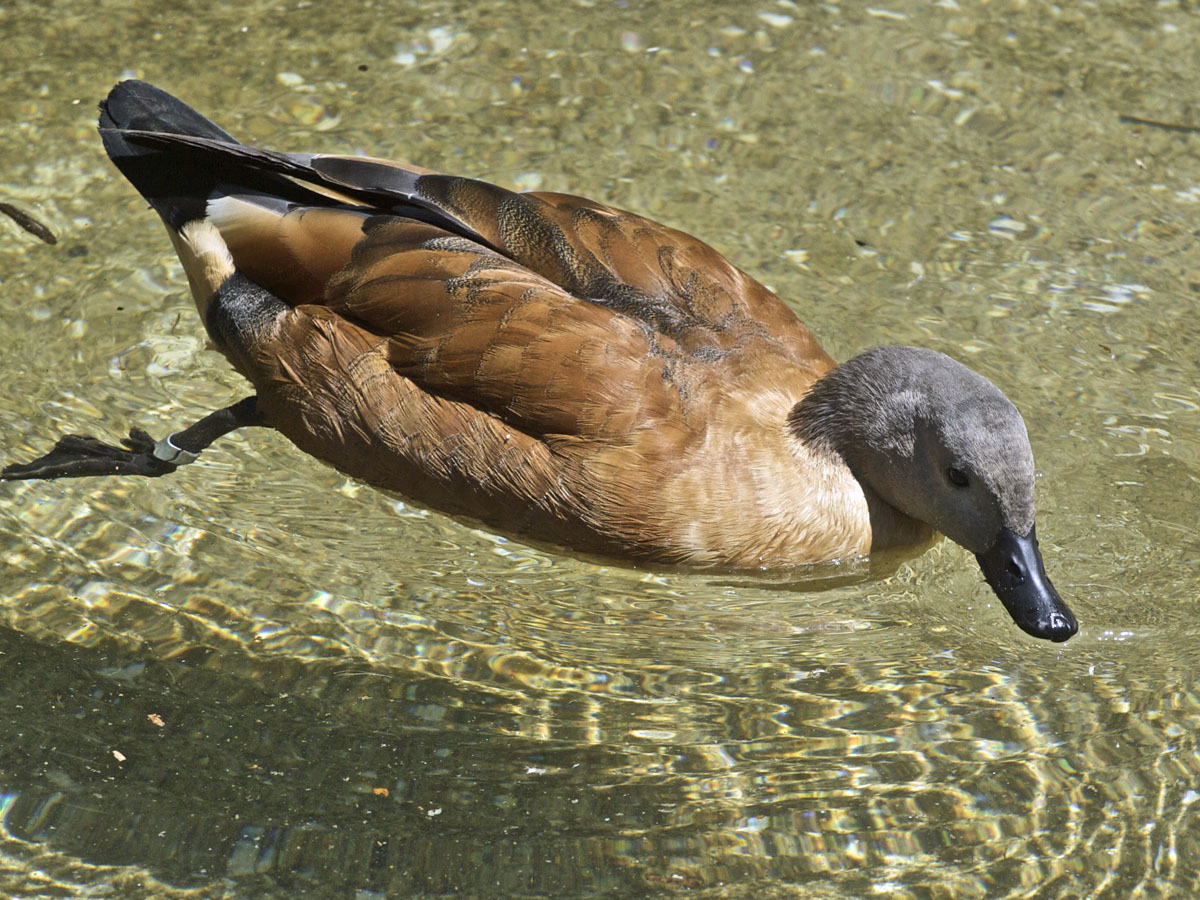
Shelduck Allies
There are a number of species that are tentatively placed in the shelduck subfamily that have previously be place elsewhere. Undoubtedly, some of the species will move again. This section contains the mandarin and wood ducks of genus Aix, torrent duck (Merganetta armata), Salvadori's teal (Salvadorina waigiuensis), and the South American steamer-ducks of genus Tachyeres.
Genus Aix
The members of genus Aix have been placed here with in the shelduck subfamily, but they are also close to the dabbling ducks.
Duck, Mandarin Aix galericulata Found: Asia
Description: The male mandarin duck has a red bill, white eye-ring, reddish face, purple breast with two vertical white bars, ruddy flanks, and two orange "sails" at the back. The female has grey upperparts and head, white eye-ring and stripe running back from the eye, white at base of it pale-tipped bill, mottled grey and white breast, and a white belly. The female mandarin duck and female wood duck are similar. Only the wood duck has a bright yellow eye-ring.
Range: Asia (eastern Russia and China; also Japan). Introduced: North America, Europe.
Habitat: Fresh waterbodies with emergent vegetation. Migrates south or to lower elevations.
Diet: Seeds, nuts, grains, aquatic plants, insects, snails, fish.
Conservation status: Least Concern.
Image by: 1, 2, 4) Dick Daniels - Sylvan Heights 3) Dick - Flamingos Wildlife Refuge Video by Avibirds. Range: Asia (eastern Russia and China; also Japan). Introduced: North America, Europe.
Habitat: Fresh waterbodies with emergent vegetation. Migrates south or to lower elevations.
Diet: Seeds, nuts, grains, aquatic plants, insects, snails, fish.
Conservation status: Least Concern.
1) Pair 2) Female 3, 4) Male
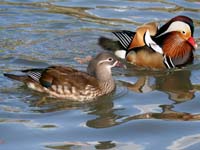
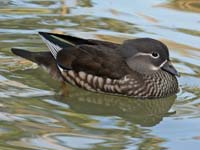
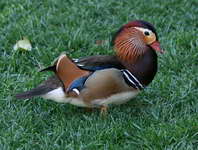
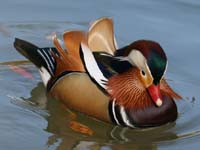
Duck, Wood Aix sponsa
Description: The breeding male wood duck has a green and purple head with a white cheek border, white median crown stripe, and white collar. It also has a white breast stripe. The back is dark brown and the flanks are green. It has red eye-rings. The female has grey upperparts and head, white stripe running back from the eye, thin yellow eye-ring surrounded by a white eye-ring. The nonbreeding male is similar to female, but has no white around the eyes. The female mandarin duck and female wood duck are similar. Only the wood duck has a bright yellow eye-ring.
Range: North America, Caribbean.
Habitat: Freshwater waterbodies with access to woods.Nests located in tree hollows. Northern population migrates to southern United States, others are sedentary. Beavers created a habitat favored by wood ducks.
Diet: Nuts, crop dregs, aquatic plants, grasses, crustaceans, aquatic insects, fish. Feed by grazing or dabbling.
Conservation status: Least Concern.
Image by: 1) Alan D. Wilson - British Columbia 2) Alan Vernon - California 3) Dick - Cape
Fear Acquarium, NC 4) Dick - Sylvan Heights Range: North America, Caribbean.
Habitat: Freshwater waterbodies with access to woods.Nests located in tree hollows. Northern population migrates to southern United States, others are sedentary. Beavers created a habitat favored by wood ducks.
Diet: Nuts, crop dregs, aquatic plants, grasses, crustaceans, aquatic insects, fish. Feed by grazing or dabbling.
Conservation status: Least Concern.
1, 2) Female 3, 4) Male


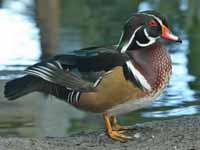
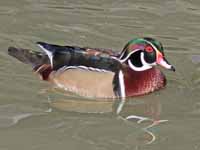
Genus Merganetta - 1 species
The torrent duck is currently placed in the shelduck subfamily. The Salvadori's teal is also in the shelduck subfamily, another species that prefers fast moving streams. A case of convergent evolution or a distant relative?
Duck, Torrent Merganetta armata
Description: The torrent duck is found around rapidly moving water (torrents). It is a powerful swimmer, even in white water. Similarly, it is a reluctant flyer. The male has grey upperparts and light to dark underparts (subspecies dependent). The head and neck are white with black streaks; the bill is red. The female has grey upperparts and head. The throat and underparts are orange.
Range: South America along the Andes.
Habitat: Fast moving streams and rivers.
Diet: Aquatic invertebrates.
Conservation status: Least Concern.
Image by: 1, 3) Aljandro Bayer Ta mayo 2) ljndr - Argentina 4) Brendan_Ryan - ChileRange: South America along the Andes.
Habitat: Fast moving streams and rivers.
Diet: Aquatic invertebrates.
Conservation status: Least Concern.
1) Pair 2) Female 3, 4) Male
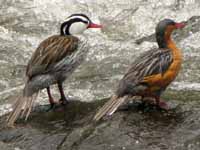
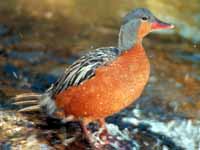
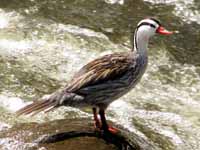

Genus Salvadorina - 1 species
Salvadori's teal is currently placed in the shelduck subfamily. At one time it was placed in the dabbling duck subfamily due to its general appearance. The torrent duck is also in the shelduck subfamily, another species that prefers fast moving streams. A case of convergent evolution or a distant relative?
Teal, Salvadori's Salvadorina waigiuensis
Description: The Salvadori's Teal has a dark brown head and neck. The upperparts and flanks are dark brown too and are heavily barred. The underparts are off-white, legs are orange, and the bill is yellow. It is called a teal because of is small size.
Range: New Guinea.
Habitat: Fast mountain streams, but also slower moving ones too.
Diet: Insect larvae, mature insects.
Conservation status: The Salvadori's teal is considered Vulnerable because of its restricted habitat which could become polluted or subject to invasive species of fish.
Image by: 1) John Gerrard Keulemans 2) Nik_BorrowRange: New Guinea.
Habitat: Fast mountain streams, but also slower moving ones too.
Diet: Insect larvae, mature insects.
Conservation status: The Salvadori's teal is considered Vulnerable because of its restricted habitat which could become polluted or subject to invasive species of fish.
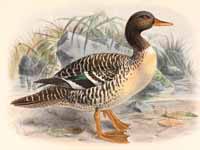
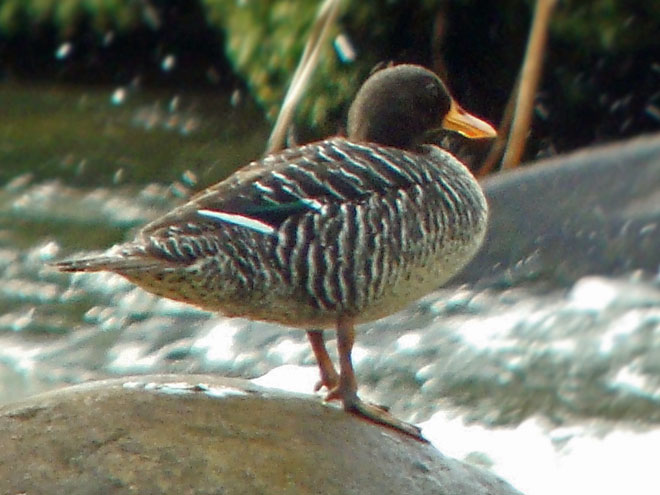
Genus Tachyeres
There a 4 species of steamer-ducks. Three are flightless and one can fly, but only rarely. The common name "steamer ducks" refers to how, when swimming fast, they flap their wings into the water as paddles, creating an effect like a paddle steamer. They feed on mollusks, crustaceans and other aquatic invertebrates. The steamer-ducks have been traditionally been listed with shelducks, but DNA evidence indicates they are closer to the bronzed-winged duck of the dabbling duck subfamily.
Duck,_Falkland Steamer- Tachyeres brachypterus
Description: The Falkland streamer-duck, which cannot fly, has mainly grey plumage with a white eye-ring. The belly is white. The male has a pale head and neck. The female has a grey head and a white stripe behind the eye.
Range: Falkland Islands.
Habitat: Rocky islands and protected bays. Also ponds that are close to the coast.
Diet: Mollusks, crustaceans and other aquatic invertebrates. Forage by diving or dabbling.
Conservation status: Least Concern.
Image by: 1) In_Vitrio 2, 3) Nick Athanas 4) David Cook Range: Falkland Islands.
Habitat: Rocky islands and protected bays. Also ponds that are close to the coast.
Diet: Mollusks, crustaceans and other aquatic invertebrates. Forage by diving or dabbling.
Conservation status: Least Concern.
1) Pair 2) Female 3, 4) Male
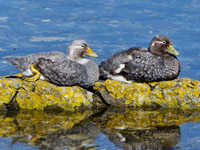
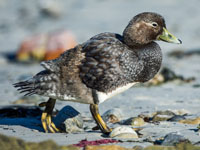
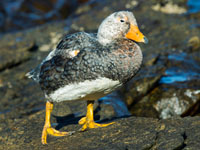
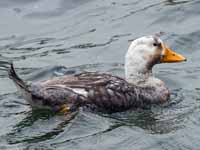
Duck,_Flightless Steamer- Tachyeres pteneres
Description: The flightless streamer-duck, also known at the Fuegian steamer-duck, is one of three species of steamer-ducks that is flightless. It is the largest steamer-duck. In fact, at up to 7 kg, it is the largest non-domestic duck or goose species in the world. It has mainly dark grey plumage. The belly is white and there is a white eye-ring. The female is smaller than the male and a slightly darker grey. Both sexes have an orange with a black nail at the tip.
Range: Pacific coast from Chile to tip of South America.
Habitat: Rocky coasts, up to 5 km offshore.
Diet: Mollusks, crustaceans, fish; also snails, insect larvae when feeding young. Forages by diving or dabbling.
Conservation status: Least Concern.
Image by:
1) Olaf Riemer 2) Alois Staudacher 3) Nick Athanas - ArgentinaRange: Pacific coast from Chile to tip of South America.
Habitat: Rocky coasts, up to 5 km offshore.
Diet: Mollusks, crustaceans, fish; also snails, insect larvae when feeding young. Forages by diving or dabbling.
Conservation status: Least Concern.
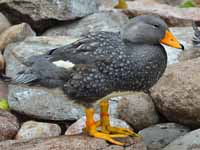
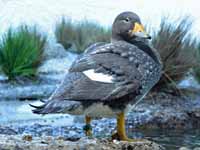

Duck,_Flying Steamer- Tachyeres patachonicus
Description:The flying steamer-duck, the smallest of the genus, is the only steamer-duck that can fly and the only one found on inland lakes. It has mainly grey plumage with a white eye-ring which is more prominent on the female. The head is usually paler than the body; the belly is white. The bill has a black "nail" at the tip. The female has a white stripe behind eye. The male bill is almost entirely yellow / orange. The female's bill has less orange / yellow on the bill than the male. It is extremely difficult to tell the difference between a fly-ing steamer-duck and a Falkland steamer-duck in the field. The flying-streamer is smaller. If the steamer is on a freshwater lake and more than a couple of km inland, then it must be the flying-steamer as a flightless steamer could not walk that far!
Range: South America (southern).
Habitat: Fresh and saline aquatic environments.
Diet: Mollusks, crustaceans and other aquatic invertebrates. Forages by diving.
Conservation status: Least Concern.
Image by: 1) Murray_Foubister 2, 3) Charlie Westerinen - Ushuaia, Argentina 4) Paul_and_JillRange: South America (southern).
Habitat: Fresh and saline aquatic environments.
Diet: Mollusks, crustaceans and other aquatic invertebrates. Forages by diving.
Conservation status: Least Concern.
!) Female left, male right 2, 3) Female 4) Male
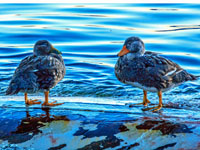
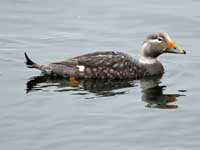
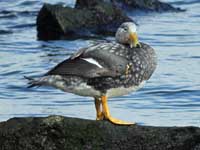
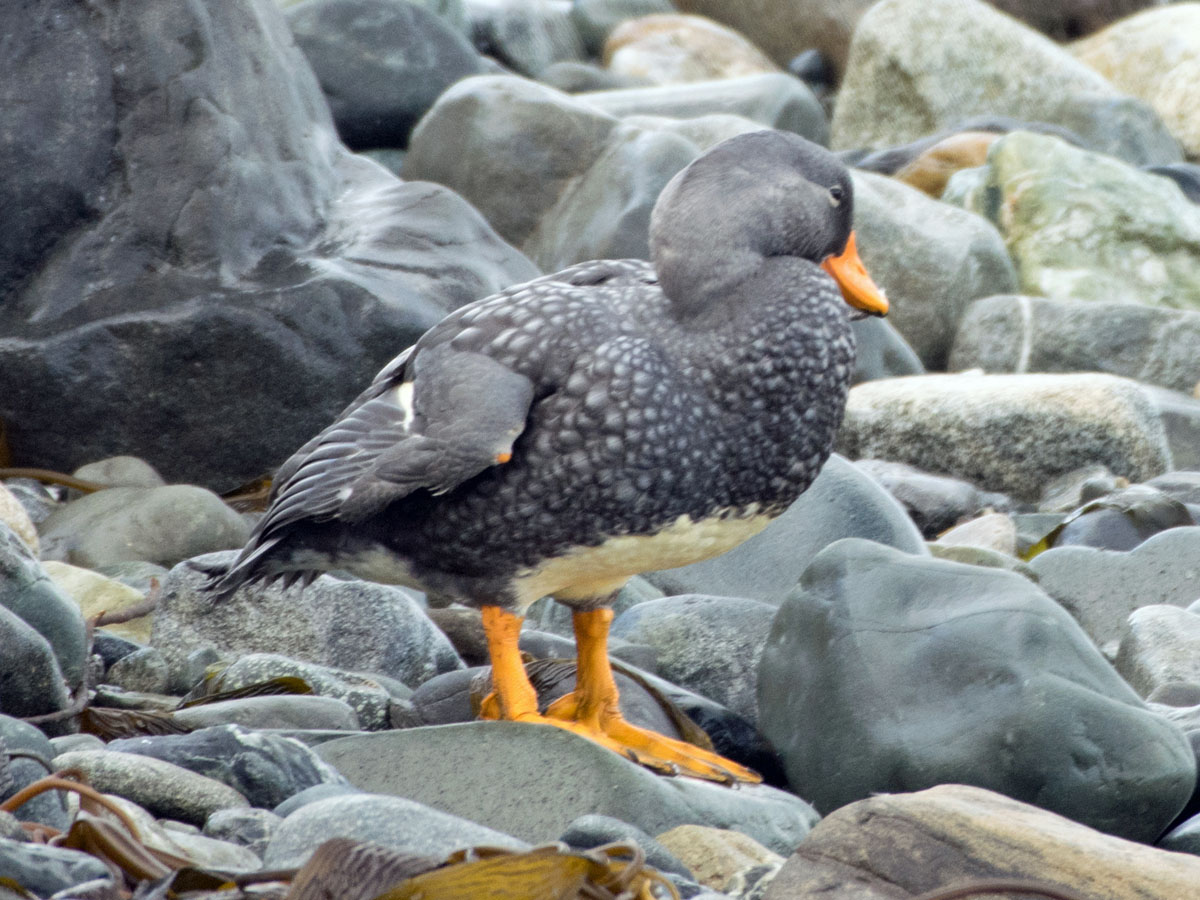
Duck,_White-headed Steamer- Tachyeres leucocephalus
Description:The white-headed streamer-duck, also known as the Chubut steamer-duck after the region where it is found, has mainly dark grey plumage with a scalloped appearance. The male has a white head and neck; these are brown on the female. Their bill, legs, and feet are yellow / orange.
Range: Atlantic coast of Argentina.
Habitat: Rocky coast.
Diet: Mollusks and crustaceans, especially crabs. Prey obtained by head dipping, surface filtering, and diving.
Conservation status: It is Vulnerable due to habitat distruction of its breeding area. Oil spills have been particularly harmful.
Image by:
1) Nick Athanas - Argentina 2) Dominic_SheronyRange: Atlantic coast of Argentina.
Habitat: Rocky coast.
Diet: Mollusks and crustaceans, especially crabs. Prey obtained by head dipping, surface filtering, and diving.
Conservation status: It is Vulnerable due to habitat distruction of its breeding area. Oil spills have been particularly harmful.
1) Pair, male in front 2) Male
